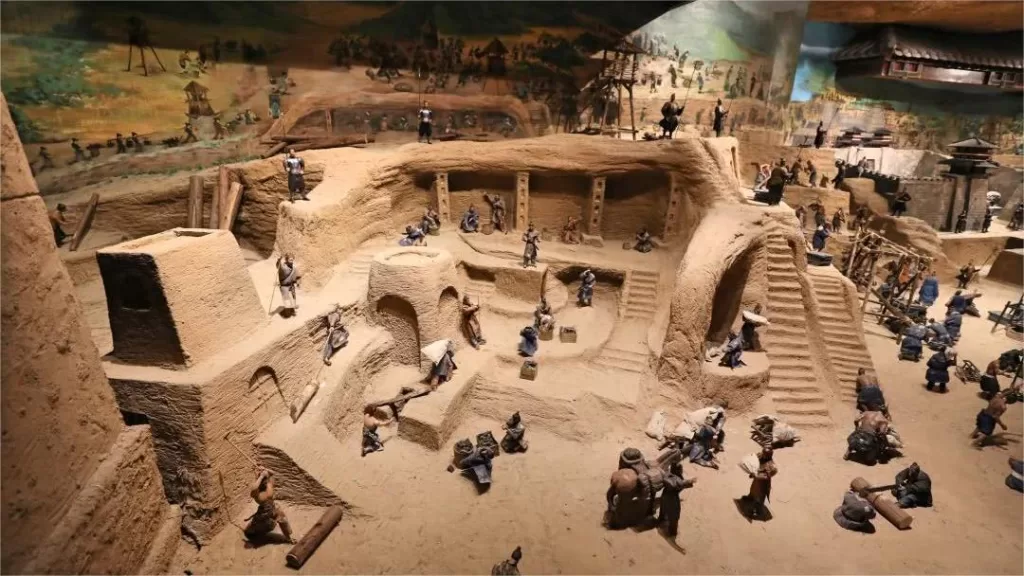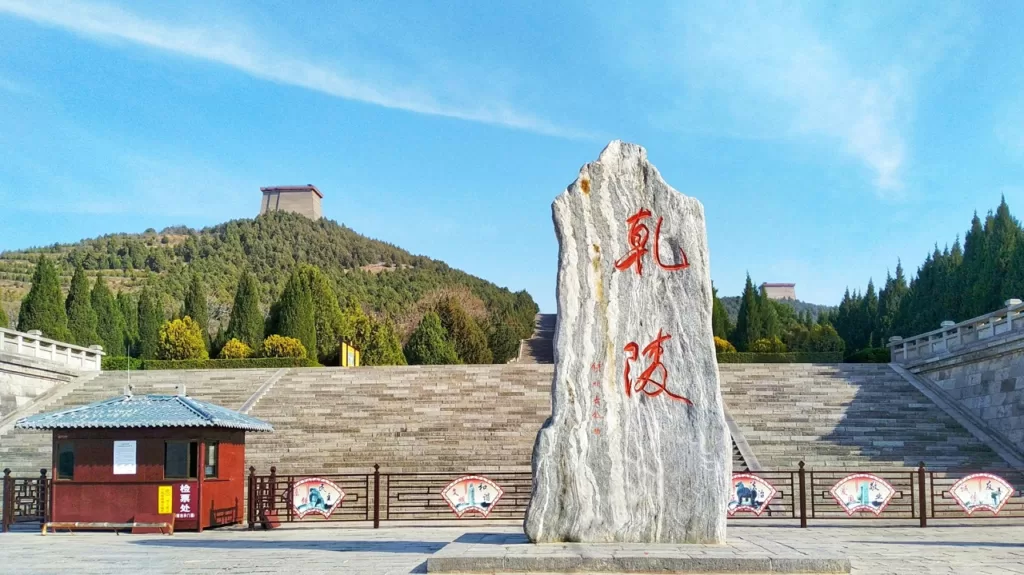The Han Yang Ling Mausoleum, known as 汉阳陵 (Hanyang Ling) in Chinese, is a historical treasure located in the city of Xi’an, China. This magnificent burial site holds the remains of Emperor Jing of the Western Han Dynasty, Liu Qi, and his queen, Wang Shi. Emperor Jing was the fourth emperor of the Western Han Dynasty. His reign saw the establishment of a period of prosperity and stability, in collaboration with his father, Emperor Wen, Liu Heng. This era laid the foundation for the ambitious territorial expansions and reforms of his successor, Emperor Wu, Liu Che.
Han Yang Ling Mausoleum consists of two main areas: the North and South zones. Visitors can purchase tickets at the ticket booth located in the North Zone. A convenient shuttle service connects the two zones, and the shuttle fee is included in the ticket price. The shuttle departs approximately every 20 minutes, but if you prefer to walk, it takes around 10 minutes to move between the North and South zones.
Han Yang Ling Mausoleum is a testament to the rich history of China, an architectural marvel, and a treasure trove of ancient artifacts that continue to captivate and educate people from all corners of the world. It stands as a tribute to the Western Han Dynasty, reminding us of the enduring legacy of this remarkable period in Chinese history.
Table of Contents
- Basic Information
- Location and Transportation
- Highlights of Han Yan Ling Mausoleum
- Vlog about Han Yang Ling Mausoleum
- Useful Tips Summarized from Reviews
- Other Mausoleums in Shaanxi
Basic Information
| Website | http://www.hylae.com/ |
| Estimated Length of Tour | About 1.5 hours |
| Ticket Price | 70 RMB |
| Opening Hours | 8.30 – 18.30; Last admission: 17.00 |
| Telephone Number | 0086-029-62657530 |
Location and Transportation
The Han Yang Ling Mausoleum is situated about 20 kilometers north of the city center in the Weicheng district. It is part of the larger Han Yang Ling Scenic Area, which also includes the Yangling Agricultural Hi-tech Industry Demonstration Zone and the Han Yang Ling Museum. Because of its relatively remote location, public transport is not very convenient.
Bus: Take bus 882 or 884 at Jingkaiqu Zhengwu Fuwu Zhongxin Stop (经开区政务服务中心), get off at Gaozhuang Zhen Zhengfu (高庄镇政府), and walk about 2.1 kilometers to the south to reach the mausoleum.
Taxi: The Han Yang Ling Mausoleum is about 24 kilometers away from the Xi’an Railway Station. It takes approximately 1 hour and costs 65 RMB to get there by taxi.
Highlights of Han Yan Ling Mausoleum
The Underground Museum

The underground museum, which is an integral part of the mausoleum complex, is a marvel of modern architecture and preservation techniques. It employs glass walls and passageways to separate visitors from the precious artifacts, maintaining distinct temperature and humidity levels in each environment. As you walk through the underground passageway into the museum, you’ll encounter a breathtaking display of terracotta figurines and pottery vessels. Peering down, you’ll see thousands of artifacts, including various types of terracotta figurines such as soldiers, dancers, palace attendants, and animals. These figurines are approximately one-third the size of real humans. The collection also includes contemporary everyday items, chariots, and horse harnesses, all illuminated by soft, ambient lighting, creating an almost surreal time-travel experience. Visitors to the museum can also enjoy a mesmerizing “holographic imaging” show, lasting approximately 20 minutes, which vividly portrays the vibrant court life of the past.
The Scale of the Mausoleum

The entire Han Yang Ling Mausoleum complex stretches over 6 kilometers from east to west and is 1 to 3 kilometers wide from north to south, covering an area of approximately 12 square kilometers. The mausoleum mound itself stands at a height of around 31 meters, with a base that measures 160 meters on each side. The top of the mound spans 54 meters from east to west and 55 meters from north to south, forming a square layout for the mausoleum. Four gates, equally spaced at a distance of 110 meters from the central part of each side, grant access to the inner sanctum. Radiating outwards from the outer edge of the mound, 81 burial pits are found. These external pits are a crucial part of the emperor’s burial site, each taking the form of a rectangular pit, three meters deep and 2.4 meters wide.
The Sacrificial Pits

The sacrificial pits, occupying 96,000 square meters, are particularly impressive. They house densely arranged groups of terracotta warriors, granaries, and terracotta animals, including cows, sheep, pigs, dogs, and chickens. In addition to these, there are sets of pottery, iron, and copper household items. These discoveries offer a comprehensive glimpse into the military and logistical aspects of the Han Dynasty. Furthermore, they reflect not only the burial practices and rituals of the time but also the flourishing economy, military might, and material prosperity of the Western Han Dynasty.
Vlog about Han Yang Ling Mausoleum
Useful Tips Summarized from Reviews
Transportation: Take Metro Line 2 and get off at Red Cross Hospital North Station. From there, you can easily hail a taxi to Han Yang Ling Mausoleum. Upon returning, you can also take a taxi directly back to this metro station, which is more convenient than Xi’an North Railway Station. The metro exit is quicker, and taxis are more readily available.
Recommendation on Departure: It’s advisable to leave Han Yang Ling Mausoleum before it gets too late, as taxi availability might decrease later in the day.
Exploring the Tombs: The Han Yang Ling Mausoleum is quite expansive, with various points of interest spaced apart. As you’ll be walking outdoors for most of the visit, it’s best to choose a time when the weather isn’t too hot for your excursion.
Layout of the Mausoleum: The mausoleum is divided into two main areas: the north and south zones. The south zone features the Archaeological Exhibition Hall and the remains of ancestral temples, while the north zone contains the Emperor’s Tomb and associated burial pits, including the Southern Gatehouse Ruins. It’s recommended to explore the south zone first before proceeding to the north zone to avoid backtracking.







The Hanyangling Museum is quite spacious. The entrance ticket only covers two exhibition halls: the Outer Tomb Pit Exhibition Hall and the Archaeological Exhibition Hall, so you need to buy one ticket for both. The other areas are free of charge. If you have time, I recommend renting an audio guide for 20 yuan; it lets you take your time and listen closely. Just be mindful not to leave too late, as it may be difficult to find a taxi.
At the entrance of the Hanyangling Mausoleum, visitors are required to wear shoe covers. Once you step inside, you are immediately struck by its grandeur. The lighting is limited, and the passageways only meet the basic requirements to prevent visitors from slipping. In the dim light, the illuminated excavation site becomes very clear, and with the few visitors present, there is a solemn atmosphere filled with quiet reverence.
Every weekend, there’s a direct bus from the D3 exit of the Administrative Center subway station (行政中心) to Hanyangling. The one-way ticket price is 5 yuan, making it convenient, quick, and cost-effective.